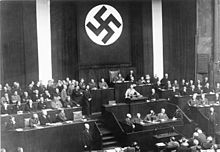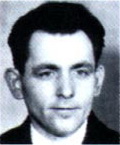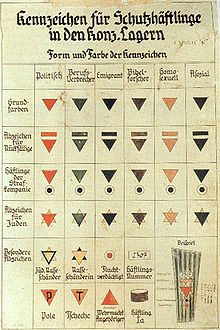Concentration camp inmate
As concentration camp prisoners, prisoners of concentration camps or concentration camp inmates were used by the Nazis in the concentration camps detained prisoners designated for which, with few exceptions, the work requirement was. The vast majority of the prisoners was no court decision or judicial order of detention , but arbitrarily to arrest by police or party members of the NSDAP under the pretext of so-called protective custody or after mass deportations held indefinitely imprisoned in concentration camps under poor conditions. This was a central component of the suppression system of the Nazi dictatorship in Germany. The prison conditions alone led to the death of thousands of these prisoners due to the systematic malnutrition and unsanitary conditions. In addition, serious causes of death as physical work, which withheld medical care after accidents or diseases and serious physical abuse to excess killings by the came Schutzstaffel assumed the NSDAP (SS) guards. Most of them were members of the SS-Totenkopfverband .
Legal basis
The first basis for imprisonment in concentration camps was the “ Ordinance for the Protection of People and State ” (“Reichstag Fire Ordinance ”) issued by Interior Minister Wilhelm Frick after the Reichstag fire on February 27, 1933 .
With this ordinance, based on Article 48 of the Weimar Constitution , political opponents could and were taken into protective custody that was not subject to judicial control without charge .
First arrests
The first prisoners were members of the KPD , who were systematically arrested after the Reichstag fire and taken to early camps or wild camps. In March 1933 the Schutzstaffel (SS) and Sturmabteilung (SA) set up the Dachau concentration camp as the first “systematic” camp .
Legal background
Protection from the communists - who were held responsible for the fire in the Reichstag and classified as enemies of the republic - was given as the reason for the submission of the regulation to Reich President Paul von Hindenburg . But almost everyone could be taken into protective custody.
The preamble to the text of the law mentioned unilaterally an anti-communist orientation. On the one hand, this signaled a restriction, on the other hand, the state now evidently left its neutral position and took sides in an ideological struggle. The ordinance subsequently enabled him to conduct a completely arbitrary arrest.
In the case of the emergency ordinances, whether there was a threat to public order was subject to the assessment of the evidence by the Reich President. The RtBVO was signed by the Reich President and came into force on February 28, 1933. The constitutionality of the regulation is regarded as proven in the history of science.
The Article 48 of the Weimar Constitution were in the arrangement and implementation of emergency decrees inter alia this legal framework before:
- The Public Order had to be at risk "significant".
- The restoration of this order had to be the aim of the declaration of the state of emergency.
- The restriction of basic civil rights was only allowed "temporarily".
However, the application - the ordinance of February 28, 1933 - did not meet the legal requirements in the following points:
- The state of emergency was used through its "expanded interpretations" to restore order in the interests of the government, not the constitution.
- The ordinance did not provide for an end to the restrictions on fundamental rights and became the “normal state” of the Nazi dictatorship. Basically, the information on the period of validity in the RtBVO was: "until further notice".

With the ordinance, the Nazi regime was able to give its rule the impression of legality in public. But it was not because of the wording “until further notice” in § 1, in the ordinance of the day after the Reichstag fire on 27/28. February 1933 that there was no longer any question of fundamental rights, but of the overall character of the RtBVO, which established a new "normal state" in the nascent Nazi dictatorship. In general, the emergency ordinances did not contradict the legal requirements of the Weimar Republic. Only after the Reichstag had passed the Enabling Act of March 24, 1933 , could the government - with an amendment to the law on March 29 - enforce the retroactive tightening of penalties even without the involvement of the Reich President: Section 5 of the RtBVO now also applied "to acts that were in the Period between January 31 and February 28, 1933 ”. A break with the law was accomplished with this extension. Section 5 violated the prohibition of retroactive effects , which was already mentioned as one of the fundamental principles of a constitutional state during the Enlightenment .
Inmate groups
Since the first concentration camps were set up, inmates have been divided into different groups and marked accordingly. These had a direct impact on the treatment, stigmatization and use of the prisoners.
Administration of prisoners
In addition to the administration of the concentration camps by the five departments of the local camp commandant offices, part of the administration was transferred to prison functionaries . The purpose of this self-administration was to transfer hierarchy, competition and division of labor to the camp inmates. This should effectively implement the purpose of the camp, according to the principle of absolute power is power in degrees . This division of power was implemented very differently by the prisoners themselves. Few took advantage of the opportunities to soften the terror, while others were in no way inferior to the SS thugs in terms of their brutality. The system was largely developed in Dachau by Theodor Eicke and was later transferred to all main and sub-warehouses. Eicke relied on absolute drill in connection with obedience in the recruiting he carried out and was mostly implemented by the prisoners. The prisoners were exposed to unrestrained use of force. If the SS succeeded in transferring this use of force to the prisoner functionaries, the “ skull and crossbones ” men could hold back and were exonerated. This method was particularly effective during work assignments, as fewer SS men were tied up.
Hierarchy of prison functionaries
- The camp elder was responsible for the block elders and received instructions from the camp commandant, which he had to delegate to the block elders.
- The block elder was responsible for "his block" and had the task of passing on the requirements made by the camp elder to the room elder.
- The room elder had to take care of the implementation of the tasks in the rooms (bedrooms).
- Oberkapo leader of a Kapogruppe. Usually with the power of command in the work assignment to the Kapos, but these were given by the SS and had to be implemented by him.
- Kapo A kind of auxiliary force that received orders from the senior kapo . Guards on duty and during transport to and from the place of work are responsible for bringing the concentration camp inmates to the workplaces.
Special inmates and clan prisoners

Clan prisoners
Kinship prisoners are prisoners who were not arrested directly because of their actions, their origin or religion, but because relatives had fallen out of favor with the regime. The most prominent example was the family of the Hitler assassin Claus Graf Schenk von Stauffenberg or other resistance fighters.
Special inmates
Special prisoners were prisoners with a special status, which was either given by a special act, such as B. the Hitler assassination attempt by Georg Elser or by special celebrities such. B. Politicians of the Weimar Republic, former members of the Wehrmacht as well as politicians and foreign military members manifested.
Treatment and accommodation
Relatives and special prisoners were sometimes treated differently than normal prisoners. This resulted in particularly cruel terror against prisoners such as B. Carl von Ossietzky as well as preferential treatment, especially with prominent prisoners from abroad. So these were z. B. supplied from the canteen of the SS men or not used for forced labor. Many who were classified as resistance activists were strictly isolated from other prisoners.
Around 130 prominent prisoners were housed in the Dachau concentration camp. So z. For example, the former Reich Economics Minister Hjalmar Schacht , the large industrialist and financier of the NSDAP Fritz Thyssen or the former Chief of the General Staff, Colonel General Franz Halder .
Evacuation of the clan and special prisoners
On April 24, 1945, the Dachau concentration camp was "evacuated". This meant that the special prisoners also had to be relocated. Under the direction of SS-Obersturmführer Edgar Stiller , they were brought to South Tyrol by buses and trucks, accompanied by a few dozen SS and SD guards. There a prisoner committee led by Captain Sigismund Payne Best and Bogislaw von Bonin was able to persuade the guards to give up on April 30, 1945.
See also
Web links
- Directory of special prisoners and clan prisoners in the transport to South Tyrol. ( Memento of April 29, 2015 in the Internet Archive ) (PDF file; 21 kB).
- The phenomenon of "kin liability" in National Socialist Germany. Konrad Adenauer Foundation
Individual evidence
- ↑ LeMO - Reichstag Fire Ordinance
- ↑ Thomas Raithel , Irene Strenge : The Reichstag fire regulation. Foundation of the dictatorship with the instruments of the Weimar state of emergency. In: Vierteljahrshefte für Zeitgeschichte. Volume 48, 2000, pp. 413-460.
- ↑ Categorization of inmates - haGalil.com
- ↑ Guido Knopp: The SS - A Warning of History. 2002, ISBN 3-570-00621-2 , pp. 209, 210 and 211.
- ↑ Peter Koblank: The Liberation of Special Prisoners and Kinship Prisoners in South Tyrol . Online edition Myth Elser, 2006.


